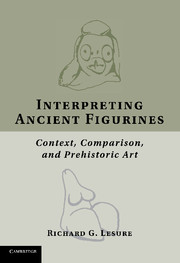Book contents
- Frontmatter
- Contents
- Figures and Tables
- Acknowledgments
- Introduction
- One Universalist Explanation and Prehistoric Figurines
- Two Comparison and Context
- Three The Questions We Ask of Images
- Four A Cross-Cultural Explanation for Female Figurines?
- Five Mesoamerican Figurines and the Contextualist Appeal to Universal Truths
- Six Figurines, Goddesses, and the Texture of Long-Term Structures in the Near East
- Seven On Figurines, Femaleness, and Comparison
- Notes
- Bibliography
- Index
Three - The Questions We Ask of Images
Published online by Cambridge University Press: 01 March 2011
- Frontmatter
- Contents
- Figures and Tables
- Acknowledgments
- Introduction
- One Universalist Explanation and Prehistoric Figurines
- Two Comparison and Context
- Three The Questions We Ask of Images
- Four A Cross-Cultural Explanation for Female Figurines?
- Five Mesoamerican Figurines and the Contextualist Appeal to Universal Truths
- Six Figurines, Goddesses, and the Texture of Long-Term Structures in the Near East
- Seven On Figurines, Femaleness, and Comparison
- Notes
- Bibliography
- Index
Summary
Figurines from different contexts may be physically similar or they may resemble one another as assemblages. For instance, contexts of recovery may be similar or predominant themes may be shared. The question I am pursuing is how – or whether – such observations should affect our social interpretations. The challenge is to reformulate material similarities into social terms without overburdening them so heavily with partisan theory that our conclusions are from that point foreordained and archaeological evidence no longer matters. Our newly acquired contextualist strategy prompts us to begin by considering the resemblant traits in their original contexts, in interplay with other traits. We would then compare the resulting contextualizations. It is a promising strategy, but the way forward still seems difficult. Let us therefore jump to the end-products of analyses. Sometimes the social interpretations of similar figurines from unrelated contexts resemble one another. Is it possible to identify the source of such convergence?
Let us consider a specific case. Five papers find that prehistoric figurines from different time periods in different parts of the world depict women at different stages of their lives. Patricia Rice argues that figurines of the European Paleolithic “represent women of different ages in proportion to their probable actual frequency in the population.” According to Avi Gopher and Estelle Orrelle, Yarmukian pebble figurines from the Southern Levant some twelve millennia later comprise a record of age differences among females “from girlhood up to perhaps menopause.”
- Type
- Chapter
- Information
- Interpreting Ancient FigurinesContext, Comparison, and Prehistoric Art, pp. 48 - 67Publisher: Cambridge University PressPrint publication year: 2011



